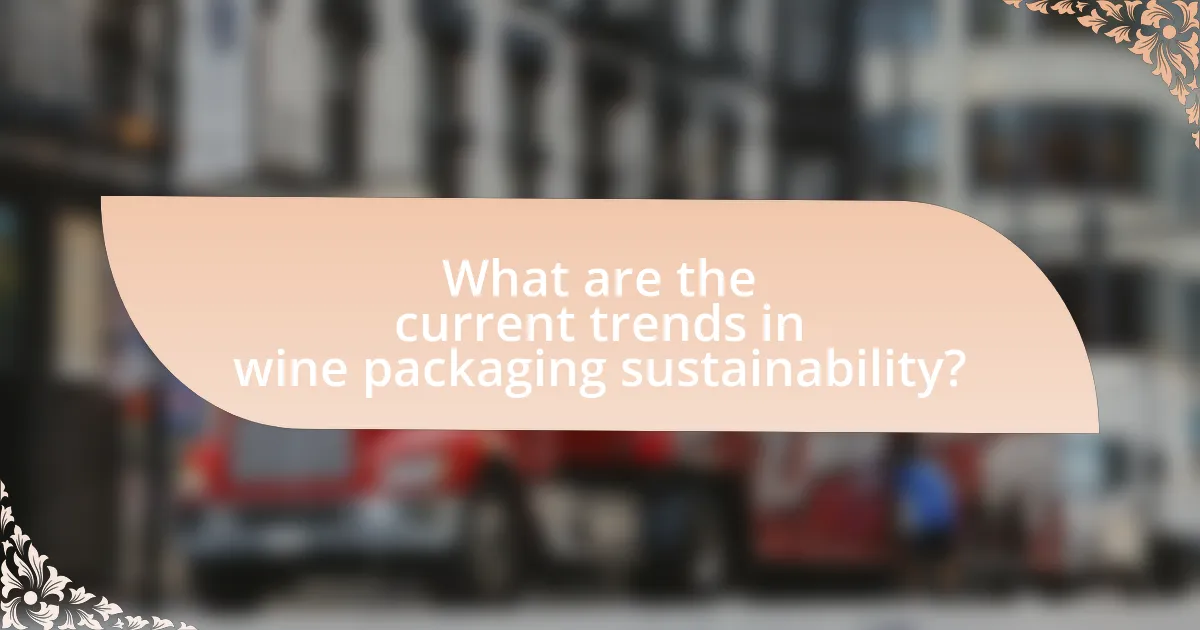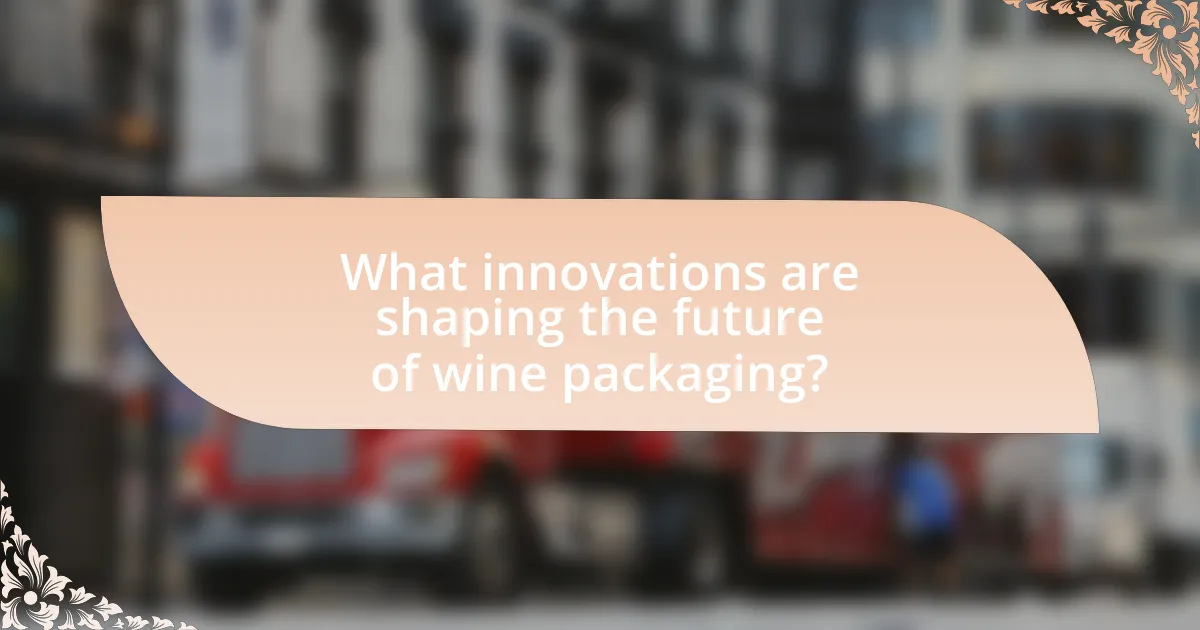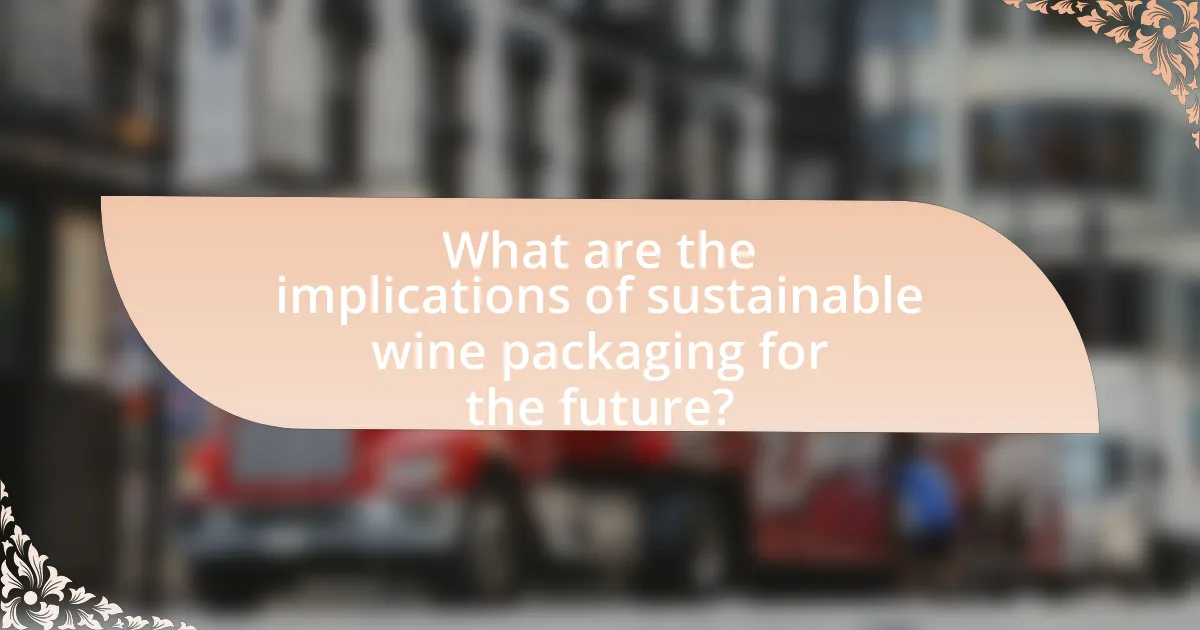The article focuses on the future of wine packaging, emphasizing trends in sustainability and consumer appeal. It outlines current practices such as the use of lightweight bottles, alternative materials like bag-in-box and Tetra Pak, and recycling initiatives that align with consumer preferences for eco-friendly products. The discussion includes the impact of sustainable materials on the environment, the importance of packaging design in consumer perception, and the role of technological advancements in enhancing sustainability. Additionally, it addresses the challenges wineries face in adopting sustainable packaging and offers strategies for effectively communicating sustainability efforts to consumers.

What are the current trends in wine packaging sustainability?
Current trends in wine packaging sustainability include the use of lightweight bottles, alternative packaging materials, and increased recycling initiatives. Lightweight bottles reduce the carbon footprint associated with transportation, as they require less energy to produce and transport. Alternative materials, such as bag-in-box and Tetra Pak, are gaining popularity due to their lower environmental impact compared to traditional glass bottles. Additionally, many wineries are implementing recycling programs and using post-consumer recycled materials in their packaging, aligning with consumer demand for eco-friendly practices. According to a 2022 report by the Wine Institute, 70% of consumers prefer brands that demonstrate sustainability efforts, highlighting the importance of these trends in the wine industry.
How is sustainability influencing wine packaging choices?
Sustainability is significantly influencing wine packaging choices by driving the adoption of eco-friendly materials and practices. Wine producers are increasingly opting for lightweight glass bottles, recycled materials, and alternative packaging options like boxes and pouches to reduce carbon footprints. For instance, a study by the Wine Institute found that lightweight bottles can decrease greenhouse gas emissions by up to 30% compared to traditional bottles. Additionally, many wineries are implementing sustainable practices such as using biodegradable labels and natural corks, which further align with consumer demand for environmentally responsible products. This shift not only meets regulatory pressures but also caters to a growing market of environmentally conscious consumers, enhancing brand loyalty and appeal.
What materials are being prioritized for sustainable wine packaging?
Sustainable wine packaging is prioritizing materials such as recycled glass, lightweight glass, biodegradable plastics, and alternative materials like bag-in-box and Tetra Pak. Recycled glass reduces energy consumption and carbon emissions during production, while lightweight glass minimizes transportation impacts. Biodegradable plastics offer a solution for single-use packaging, and bag-in-box and Tetra Pak provide efficient, recyclable options that extend shelf life and reduce waste. These materials align with the growing consumer demand for environmentally friendly practices in the wine industry.
How do these materials impact the environment?
Wine packaging materials significantly impact the environment through their production, use, and disposal processes. Traditional glass bottles contribute to high carbon emissions during manufacturing and transportation, while plastic alternatives can lead to increased pollution and landfill waste due to their non-biodegradable nature. According to a study by the University of California, Davis, the carbon footprint of glass bottles is approximately 1.5 kg CO2 per bottle, whereas lightweight alternatives can reduce emissions by up to 30%. Additionally, sustainable materials like recycled paper and biodegradable plastics can mitigate environmental harm by reducing resource consumption and waste.
Why is consumer appeal important in wine packaging?
Consumer appeal is crucial in wine packaging because it directly influences purchasing decisions and brand perception. Attractive packaging can enhance the perceived quality of the wine, making it more desirable to consumers. Research indicates that 70% of purchasing decisions are made at the point of sale, highlighting the importance of visual appeal in capturing consumer attention. Additionally, effective packaging communicates brand values, such as sustainability, which resonates with environmentally conscious consumers. This alignment with consumer preferences can lead to increased sales and brand loyalty, reinforcing the significance of consumer appeal in wine packaging.
What role does packaging design play in consumer perception?
Packaging design significantly influences consumer perception by shaping first impressions and conveying brand values. Effective packaging can attract attention, communicate quality, and differentiate products in a competitive market. For instance, research indicates that 72% of consumers form their first impression of a product based on its packaging alone, highlighting its critical role in decision-making. Additionally, sustainable packaging design can enhance brand image, as 66% of consumers are willing to pay more for products with environmentally friendly packaging, demonstrating the impact of design on consumer preferences and purchasing behavior.
How can sustainable packaging enhance brand loyalty?
Sustainable packaging enhances brand loyalty by aligning with consumer values and preferences for environmentally responsible practices. Research indicates that 66% of global consumers are willing to pay more for sustainable brands, demonstrating a direct correlation between sustainable packaging and increased customer loyalty. Brands that adopt eco-friendly packaging not only attract environmentally conscious consumers but also foster a sense of trust and commitment, as customers perceive these brands as socially responsible. This perception is supported by a study from Nielsen, which found that 73% of millennials are willing to pay extra for sustainable offerings, further solidifying the link between sustainable packaging and brand loyalty.

What innovations are shaping the future of wine packaging?
Innovations shaping the future of wine packaging include sustainable materials, lightweight designs, and smart technology integration. Sustainable materials, such as biodegradable and recyclable options, are increasingly being adopted to reduce environmental impact, with companies like Vinventions leading the way in eco-friendly closures. Lightweight designs, such as bag-in-box and alternative formats, are gaining popularity as they lower transportation costs and carbon footprints. Additionally, smart technology, including QR codes and augmented reality, enhances consumer engagement by providing information about the wine’s origin and production process, thereby appealing to tech-savvy consumers. These innovations reflect a growing trend towards sustainability and consumer interaction in the wine industry.
How are technological advancements affecting wine packaging?
Technological advancements are significantly enhancing wine packaging by improving sustainability, efficiency, and consumer engagement. Innovations such as lightweight bottles reduce material usage and transportation costs, while alternative packaging options like bag-in-box and cans cater to eco-conscious consumers. Additionally, smart packaging technologies, including QR codes and augmented reality, allow wineries to provide interactive experiences and detailed product information, thereby increasing consumer appeal. According to a report by Grand View Research, the global wine packaging market is projected to reach $25.5 billion by 2025, driven by these technological improvements and a growing demand for sustainable practices.
What new packaging technologies are emerging in the wine industry?
New packaging technologies emerging in the wine industry include lightweight glass bottles, alternative materials like bag-in-box and Tetra Pak, and smart packaging solutions. Lightweight glass bottles reduce transportation costs and carbon footprint, with some producers achieving a weight reduction of up to 30%. Bag-in-box packaging offers convenience and extended shelf life, appealing to consumers seeking practicality. Tetra Pak, made from renewable resources, enhances sustainability by minimizing waste. Smart packaging technologies, such as QR codes and NFC tags, provide consumers with interactive experiences and detailed product information, aligning with the trend towards transparency and engagement in the wine market.
How do these technologies improve sustainability and consumer appeal?
Technologies such as lightweight packaging, biodegradable materials, and digital labeling improve sustainability and consumer appeal by reducing environmental impact and enhancing user experience. Lightweight packaging decreases the carbon footprint associated with transportation, as it requires less energy to ship. Biodegradable materials, like plant-based plastics, minimize waste in landfills and promote eco-friendly disposal methods. Digital labeling allows for real-time information sharing, enabling consumers to make informed choices about sustainability practices, thus increasing brand loyalty. These advancements align with consumer preferences for environmentally responsible products, as evidenced by a 2021 survey indicating that 73% of consumers are willing to pay more for sustainable packaging options.
What are the challenges faced by the wine industry in adopting sustainable packaging?
The wine industry faces several challenges in adopting sustainable packaging, primarily related to cost, material availability, and consumer acceptance. The transition to sustainable materials often incurs higher production costs, which can deter wineries from making the switch, especially smaller producers with limited budgets. Additionally, sustainable packaging materials, such as biodegradable or recycled options, may not be as readily available or may lack the necessary performance characteristics, such as durability and shelf life, compared to traditional packaging. Furthermore, consumer acceptance plays a crucial role; many consumers remain unaware of the benefits of sustainable packaging or may prioritize aesthetics and brand familiarity over sustainability, making it difficult for wineries to justify the change. These challenges highlight the complexities involved in shifting towards more sustainable practices within the wine industry.
What barriers exist for wineries transitioning to sustainable materials?
Wineries face several barriers when transitioning to sustainable materials, including high costs, limited availability of sustainable options, and consumer perception. The initial investment for sustainable materials often exceeds traditional packaging, making it financially challenging for many wineries. Additionally, the supply chain for sustainable materials can be less developed, leading to difficulties in sourcing these alternatives consistently. Consumer perception also plays a role; some consumers may prioritize price over sustainability, which can deter wineries from making the switch. These factors collectively hinder the adoption of sustainable materials in the wine industry.
How can these challenges be overcome?
To overcome challenges in wine packaging sustainability, producers can adopt innovative materials and practices. Utilizing biodegradable packaging, such as plant-based plastics or recycled materials, reduces environmental impact. For instance, companies like Ecoenclose have successfully implemented sustainable packaging solutions that minimize waste. Additionally, investing in lightweight bottles can decrease transportation emissions, as lighter packaging reduces fuel consumption during shipping. Research indicates that consumers increasingly prefer brands that demonstrate environmental responsibility, making sustainable packaging not only a solution to challenges but also a competitive advantage in the market.

What are the implications of sustainable wine packaging for the future?
Sustainable wine packaging will significantly influence the future of the wine industry by reducing environmental impact and enhancing consumer appeal. As consumers increasingly prioritize eco-friendly products, wineries adopting sustainable packaging can attract a growing market segment that values sustainability, evidenced by a 2021 survey indicating that 66% of consumers are willing to pay more for sustainable brands. Furthermore, sustainable packaging options, such as lightweight bottles and biodegradable materials, can lower production costs and carbon footprints, aligning with global efforts to combat climate change. This shift not only meets consumer demand but also positions wineries as responsible stewards of the environment, fostering brand loyalty and potentially increasing market share.
How will consumer preferences shape the evolution of wine packaging?
Consumer preferences will significantly shape the evolution of wine packaging by driving demand for sustainable and innovative materials. As consumers increasingly prioritize environmental responsibility, wine producers are responding by adopting eco-friendly packaging options, such as lightweight bottles, alternative materials like Tetra Pak, and biodegradable labels. For instance, a 2021 survey by Wine Intelligence found that 62% of consumers are willing to pay more for sustainably packaged wine, indicating a clear market trend towards sustainability. This shift not only influences packaging design but also encourages brands to communicate their sustainability efforts effectively, further aligning with consumer values.
What trends are emerging in consumer demand for sustainable products?
Emerging trends in consumer demand for sustainable products include a significant increase in preference for eco-friendly packaging, transparency in sourcing, and a shift towards circular economy practices. Consumers are increasingly seeking products that minimize environmental impact, with 73% of millennials willing to pay more for sustainable offerings, according to a 2021 Nielsen report. Additionally, brands that communicate their sustainability efforts effectively are gaining consumer trust, as 66% of global consumers are willing to pay more for sustainable brands, highlighting the importance of transparency in sourcing and production methods.
How can wineries adapt to these changing preferences?
Wineries can adapt to changing consumer preferences by implementing sustainable packaging solutions. Research indicates that 74% of consumers are willing to pay more for sustainable products, highlighting the demand for eco-friendly options. By utilizing materials such as recycled glass, lightweight bottles, and alternative packaging like cans or boxes, wineries can reduce their environmental impact while appealing to environmentally conscious consumers. Additionally, wineries can enhance their marketing strategies to emphasize sustainability, thereby aligning their brand with consumer values and increasing market competitiveness.
What best practices should wineries follow for sustainable packaging?
Wineries should prioritize the use of recyclable materials, lightweight packaging, and biodegradable options for sustainable packaging. Utilizing recyclable materials, such as glass and cardboard, reduces waste and promotes a circular economy. Lightweight packaging minimizes transportation emissions, as lighter products require less energy to transport. Additionally, biodegradable options, like plant-based plastics, help reduce landfill waste. According to a study by the Wine Institute, adopting these practices can significantly lower a winery’s carbon footprint and appeal to environmentally conscious consumers.
How can wineries effectively communicate their sustainability efforts to consumers?
Wineries can effectively communicate their sustainability efforts to consumers by utilizing transparent labeling, engaging storytelling, and digital platforms. Transparent labeling allows wineries to clearly indicate sustainable practices, such as organic farming or carbon-neutral production, directly on the bottle, which has been shown to influence consumer purchasing decisions positively. Engaging storytelling about the winery’s sustainability journey can create an emotional connection with consumers, making them more likely to support brands that align with their values. Additionally, leveraging digital platforms, including social media and websites, enables wineries to share detailed information, updates, and certifications related to their sustainability initiatives, reaching a broader audience. Research indicates that 66% of consumers are willing to pay more for sustainable brands, highlighting the importance of effective communication in driving consumer engagement and loyalty.
What strategies can enhance the appeal of sustainable wine packaging?
Innovative design and consumer education are key strategies to enhance the appeal of sustainable wine packaging. Innovative design can include using visually appealing materials that reflect sustainability, such as biodegradable or recycled materials, which can attract environmentally conscious consumers. For instance, brands like Ecoenclose utilize 100% recycled materials for their packaging, demonstrating a commitment to sustainability while maintaining aesthetic appeal.
Consumer education plays a crucial role as well; informing customers about the environmental benefits of sustainable packaging can increase their willingness to purchase. Research indicates that 66% of global consumers are willing to pay more for sustainable brands, highlighting the importance of effective communication regarding the sustainability of packaging. By combining attractive design with informative marketing, wine brands can significantly enhance the appeal of their sustainable packaging.